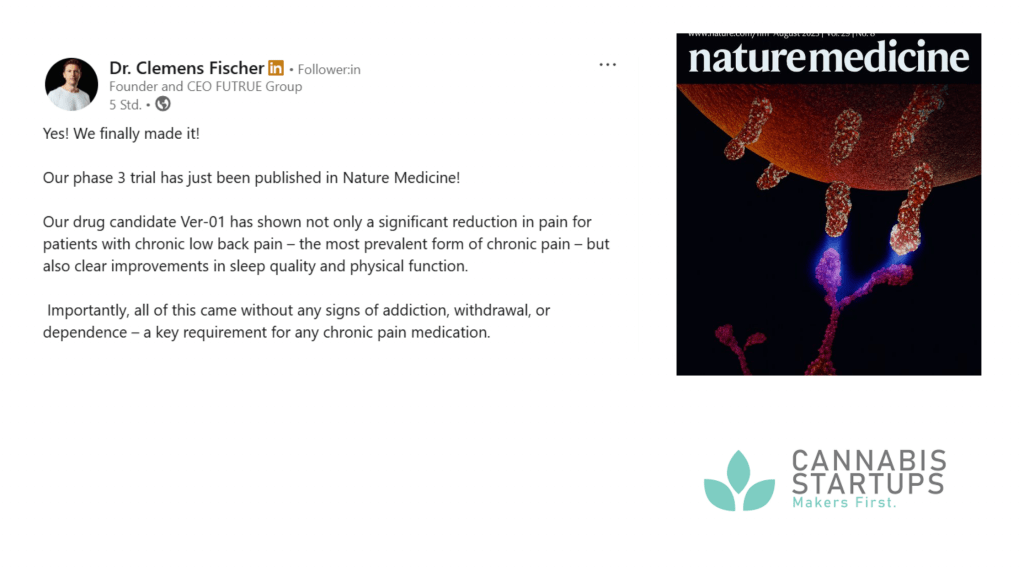The scientific breakthrough that could revolutionize pain therapy
In the latest issue of Nature Medicine, a Phase 3 study is causing a stir: VER-01, a standardized full-spectrum cannabis extract, has for the first time in a large-scale clinical trial demonstrated significant success in treating chronic back pain – without signs of addiction or withdrawal. For some, this is the long-overdue proof of cannabis’ medical efficacy. For others, the question arises: what does this mean for the existing medical cannabis market?
The study results: More than just pain reduction
The VER-CLBP-001 study followed 820 patients with chronic back pain over a period of up to 18 months. The results are impressive:
Pain reduction: Patients in the VER-01 group experienced an average pain reduction of -1.9 points on the numerical rating scale (NRS), compared to -1.4 points in the placebo group. At first glance, this may seem modest, but the -0.6-point difference was highly statistically significant.
Functional improvements: What makes the study remarkable: VER-01 not only reduced pain intensity, but also improved sleep quality (-0.7 NRS points difference versus placebo) and physical function. The Roland Morris Disability Questionnaire showed an improvement of -3.1 points under VER-01 versus -2.0 under placebo.
Safety profile: No signs of dependence, abuse, or withdrawal symptoms throughout the entire study period. The discontinuation rate due to side effects was 17.3% (versus 3.5% with placebo), with most adverse events being mild to moderate and temporary – typically dizziness, fatigue, and nausea during the titration phase.
The comparison with opioids: Particularly relevant: the number needed to treat (NNTB) for a 30% pain reduction was 6.8 – noticeably better than the NNTB of 9 for opioids. In other words: fewer patients need to be treated with VER-01 to achieve therapeutic success compared to opioids.
VER-01 is not “smoking cannabis”
One crucial point is often overlooked: VER-01 is not a typical cannabis product, as Jan Vollert, pain researcher at the University of Exeter, aptly put it: “Smoking cannabis and taking VER-01 are probably as similar as eating hazelnuts and eating Nutella.”
What makes VER-01 different?
-
Pharmaceutical standardization: Each dose contains exactly 2.5mg THC, 0.1mg cannabigerol (CBG), and 0.02mg cannabidiol (CBD). The composition is identical across all batches.
-
Full-spectrum extract: VER-01 is derived from the patented Cannabis sativa strain DKJ127 and includes not only cannabinoids but also terpenes, flavonoids, carotenoids, and phytosterols in a defined composition.
-
Oral dosage form: Administered as drops, no inhalation required.
-
Clinical validation: Developed under EMA and FDA guidelines for pain medication, tested in Phase 3 with more than 820 patients.
VER-01 is a medicine that adheres to the same regulatory standards as any other prescription drug – including approval processes, quality control, and pharmacovigilance.
Not OTC, but prescription: The regulatory path
The question of whether VER-01 will be available over the counter (OTC) can be clearly answered: No. As a THC-containing medication, it will remain prescription-only and must undergo full approval by the EMA (Europe) and FDA (USA). Market introduction is still 1–2 years away.
This also means: VER-01 will not be a “lifestyle product,” but a medicine for patients with a proven indication – in this case, chronic non-specific back pain.
The decisive question: Will VER-01 cannibalize the flower market?
For patients, doctors, and the cannabis industry, the key question is: Will pharmaceutical cannabis products like VER-01 displace the medical cannabis flower market?
Arguments for patient migration:
1. Physician acceptance: With VER-01, doctors have for the first time a cannabis product backed by robust clinical evidence. Phase 3 data from a randomized, placebo-controlled trial with more than 800 participants is a completely different caliber compared to the current evidence base for cannabis flowers.
2. Standardization: Precise dosing is a huge advantage for many patients and doctors compared to flowers with variable THC/CBD levels.
3. Reimbursement: A fully approved medicine has, in principle, better chances of reimbursement by health insurers than “simple” cannabis flowers.
4. Convenience: Oral drops are more discreet, easier to dose, and socially more acceptable than vaporizing or smoking.
Arguments for market coexistence:
1. The price problem: VER-01, as a pharma specialty, will likely cost €200–400 per month – significantly more than cannabis flowers for self-payers (€150–250/month). For the majority of patients who pay out-of-pocket, the price remains a knockout criterion.
2. Indication specificity: VER-01 is developed and approved for chronic back pain. Patients with other conditions – sleep disorders, loss of appetite, PTSD, spasticity – will still rely on flowers or other products.
3. Cannabinoid profiles: VER-01 is strongly THC-dominated (2.5mg THC, only 0.02mg CBD). Many patients prefer more balanced profiles or CBD-rich varieties – the diversity of flowers allows for individual tailoring.
4. Application preference: The fast onset of effects through inhalation is often more advantageous for acute symptoms than the delayed onset of oral intake.
5. The self-payer dilemma: In Germany, an estimated 85–90% of medical cannabis patients are self-payers. Health insurance rejection rates remain at 40–60%. VER-01 won’t change this substantially in the short term.
Will VER-01 boost cannabis prescriptions?
The optimistic thesis: VER-01 could act as a “catalyst” for broader acceptance of cannabis in medicine. If doctors see that a cannabis-based product secures EMA/FDA approval and is included in clinical guidelines, it could increase the overall willingness to prescribe cannabis flowers as well.
Reality, however, is likely different:
Institutional medicine vs. self-payer market
We will see a market segmentation:
Premium pharma segment (VER-01, Sativex & Co.):
-
Patients in university hospitals, specialized pain centers
-
Strict indication (severe CLBP after failure of other therapies)
-
Insurance reimbursement after lengthy approval process
-
Small but well-documented patient population
Mainstream flower segment:
-
Self-paying patients with diverse indications
-
Greater therapeutic flexibility
-
Lower costs
-
Less bureaucracy
-
Pragmatic doctors who already prescribe cannabis today
Why no major boost is expected:
-
Health insurers remain restrictive: Even with clinical evidence, insurers will only approve VER-01 after all other options have been exhausted. Bureaucratic hurdles remain.
-
Two-class medicine: Well-insured patients in specialized centers get VER-01 reimbursed. The rest pays out-of-pocket – and chooses the cheaper flowers.
-
Physician inertia: Most general practitioners will hesitate to prescribe cannabis even with VER-01. The “cannabis doctors” already prescribe today – for them, little will change.
-
Self-payer logic: Why should a self-payer spend €300+ on VER-01 if they can buy cannabis flowers for €180 that they can tailor to their needs?
The likely future: Evolution, not revolution
VER-01 will not revolutionize the medical cannabis market, but it will evolve it:
Short-term (1–3 years):
-
VER-01 gains approval in EU/USA
-
Introduction into pain guidelines as an option after NSAIDs and before opioids
-
Small but growing patient group in specialized centers
-
Media attention drives gradual destigmatization
-
Flower market continues to grow, primarily among self-payers
Mid-term (3–5 years):
-
More cannabis-based pharmaceuticals for other indications enter the market
-
Increased physician education, more knowledge about cannabinoid therapy
-
Insurers develop reimbursement guidelines – but narrowly defined
-
Market differentiation: pharma products for specific indications, flowers for individualized therapy
Long-term (5–10 years):
-
Cannabis medication becomes “normal” in pain therapy
-
Parallel markets: pharma segment and flower segment coexist
-
Price decline for flowers due to scaling and competition
-
Potential development of dedicated cannabis prescribing software with dosing algorithms
Conclusion: Breakthrough yes, disruption no
The VER-01 study is scientifically a breakthrough: it provides the most robust clinical evidence to date for the efficacy of a cannabis-based product in chronic pain. Andrew Moore, former pain researcher at Oxford University, called the study “terrific” and “about as good as it gets.”
For the medical cannabis market, however, this is not a disruption. VER-01 will not displace the flower market, but instead create a new premium segment. The majority of patients will continue to use cannabis flowers – due to cost, flexibility, and lack of access to expensive pharma products.
What VER-01 can achieve: legitimization. The more cannabis-based medicines clear regulatory hurdles, the more normal cannabis will become as a medication. This benefits everyone in the long run – pharma companies, flower producers, and most importantly, patients.
Pain therapy urgently needs safe, effective alternatives to opioids. VER-01 could become one of them – alongside, not instead of, medical cannabis flowers.
Disclaimer: This article does not constitute medical advice. Patients should always make therapeutic decisions in consultation with their treating physician.








